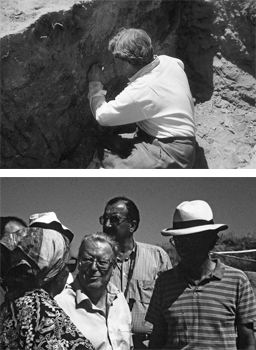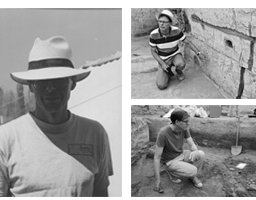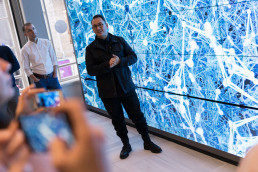The Curious Case of ÇATALHÖYÜK
A major exhibition about archaeological research on the UNESCO World Heritage site of Çatalhöyük.
The Curious Case of Çatalhöyük
Nine thousand years ago, people gathered in what is today the Konya plain; they made mud brick houses, they produced their very own clay pottery and fashioned sharp tools from volcanic glass which they brought from 200 kilometers away, they domesticated animals, and they engaged with agriculture. Furthermore, they produced a wide range of artwork in the form of wall and floor paintings, and sculptures of stone and clay. So, how do we know all this?
Since 1993, under the supervision of Ian Hodder, the Çatalhöyük Research Project has been shedding light on how one of the oldest societies of the world has made the transition from hunting to farming, and how it was organized in socio-economic terms. Hodder and his team completed their excavation in August; however, Çatalhöyük’s story, which will be passed on to the next generation of researchers under their guidance, is only beginning. Join us now and take part of this 25-year-old detective adventure.
Half a Century of Excavations
Excavations that have been ongoing since the 1960s have uncovered a densely-packed Neolithic settlement that could be dated to 7000 BC. The Çatalhöyük Research Project has unearthed traces of the Çatalhöyük people, who were one of the most complex societies of their time. A team of specialists have been worked to understand better the lives of the people who lived there.

The First Neolithic Settlement Discovered in Anatolian Lands
Until the late 1950s, there had been no evidence to support the theory that Anatolia had acted as the bridge bringing to the West the agriculture and ways of settled life that blossomed in the Near East. Then, on November 11th, 1958, two British archaeologists in their early 30s, David French and James Mellaart were in a Land Rover driven by Alan Hall, travelling through a dirt road approximately 45 km southeast of Konya. They stopped when they encountered a hill majestically rising from a barren plain and hence giving the impression that it was no ordinary mound. When they went around it and examined the findings, they understood they were on the verge of changing the history of the world. What they saw was an untouched Neolithic site! In just a few years, this mound would be known globally, causing great excitement in the archaeology community and revolutionizing the wealth of knowledge on the technology, art, culture, and beliefs of the Neolithic Age. Thanks to this, Mellaart would also became famous among archaeologists.From 1961 to 1965, supported by a team of international and Turkish researchers and Turkish workers, Mellaart unearthed 160 buildings in the first Çatalhöyük excavations. During this time, he released the findings to the public and made Çatalhöyük universally known.
Balter, M. The Goddess and the Bull: Çatalhöyük: An Archaeological Journey to the Dawn of Civilization. Free Press, 2005

Çatalhöyük Research Project
Twenty-eight years later, in 1993, another British researcher, Ian Hodder, started working on the mound.
“Every time I climb the 21-meter mound, my heart races with excitement. Although I have been working here since 1993, every time I step into those lands, I go weak at the knees. After all, the land I am stepping through contains the details of a mesmerizing settlement that hosted 3000 to 8000 people, 9000 years ago.” Ian Hodder.
Hodder has been applying novel scientific techniques to conduct intense and detailed research that can shed even more light on Mellaart’s extensive results. Hence, today’s results consist of the blend of two quite distinct research efforts.
Life at Çatalhöyük
Let’s go back to 7100 BC, back to a time when people first settled at Çatalhöyük. During this period, the site was situated in a wetland with a moist and rainy climate. A wide range of resources were available including fish, water birds, and their eggs. On drier ground were agricultural and grazing areas where herds of wild animals could be found roaming.
Çatalhöyük was home to a society undergoing a continual transformation, and by 6500 BC, radical changes took place. More efficient cooking pots were developed, which in turn created time for other activities. Domestic cattle and milk were introduced and there was an increase in housing and population density. Burials and ritual behavior also became more elaborate. In this period, many of the decorative features which make Çatalhöyük more famous, are emerged, such as figurative art. At its peak, 3000 to 8000 people lived, worked, and died here.
The work conducted indicates that while Çatalhöyük was growing, other settlements in the area were getting smaller. Hence, Çatalhöyük was a place where various groups of people from diverse cultures would come and settle and could live together. It seems that the past of the settlement is echoed in its present; today, Çatalhöyük continues to host researchers that come from various countries.
At The Trowel's Edge
Reflexive Methodology
The interpretation of archaeological sites begins before the archaeologists arrive.
Single Context Recording
When archaeologists start digging into the soil, they do not yet know…
Excavation Diaries
Since 1996, the Çatalhöyük Research Project has used diaries as a means
Priority Tours
As part of the “Reflexive Methodology,” the “Priority Tours” can be described…
From Trowel's Edge To Lab Tables
The laboratories are located next to the mound to make possible a close relationship between the excavators and specialists. In these laboratories faunal, archaeobotanical, conservational, human remains, pottery, clay objects, ground stone, obsidian, and micromorphological analyses are conducted.
Finds Lab
Clay Lab
It is no surprise that clay is the most commonly used raw material in a settlement established in the heart of the Çarşamba River valley…
Conservation Lab
In this lab, archaeologists become the doctors of artifacts… While excavations make it possible for us to understand more about…
Lithics Lab
Obsidian, which is a type of natural glass, is formed as volcanic lava cools during eruptions. Obsidian is found in very few countries…
Archaeobotany Lab
People of Çatalhöyük consumed emmer, einkorn, barley, peas, bread wheat (tiriticum aestivum), lentil, and types of vetch (vicia noena, ervum ervilia)
Fauna Lab
Wall paintings, figurines, pottery, and bucranium reliefs inform us that a large variety of animals held a prominent place in Çatalhöyük’s symbolic universe.
Human Remains Lab
Every part of a human skeleton carries all traces of life experiences and provides much information about the lifestyles and conditions of the past…

Küratör | Curator
Duygu Tarkan
Sergi Koordinatörü ve İçerik Geliştirme | Exhibition Coordinator and Content Development
Şeyda Çetin
Danışman | Consultant
Ian Hodder
ANAMED Direktörü | Director
Chris Roseevelt
Sergi Ekibi | Exhibition Team
Buket Coşkuner, Ebru Esra Satıcı, Özge Ertem Artvinli
Sergi Tasarımı | Exhibition Design
Cem Kozar, Işıl Ünal
PATTU, www.pattu.net
Ekip | Team
Canset Er, Onat Müftüoğlu, Armağan Gülhaş
Sergi Kurulumu | Installation
Sergikur
VR Çatalhöyük
Laia Pujol, Leap Project
VR Uyarlaması, Konsept ve Programlama | VR Additional Concept & Programming
Haluk Diriker
Hareketli Görseller | Motion Graphics
Hürcan Yılmazer
3D Baskılar | 3D Printing
3Dörtgen
Çatalhöyük Yayınları Derleme | Çatalhöyük Publications Selection
Mehmet Kentel, Naz Özkan, İrem Ünal
Proje Asistanları | Project Assistants
Ceren Öner, Nina Holubcova
Fotoğraflar | Photography
Jason Quinlan, Scott D. Haddow
Çeviri | Translation
Ali Kavas
Editing & Proofreading
Umur Çelikyay
Teşekkürler | Acknowledgments
Berna Alkan Koç
Bilge Küçükdoğan
Duygu Çamurcuoğlu
Dominik Lukas
Uğur Şahbaz
3D Kazı Ekibi | 3D Digging Team
Nicola Lercari, Maurizio Forte, Niccoló Dell’Unto, Arianna Campiani
Sara Perry ve Çatalhöyük Görselleştirme Ekibi | Visualisation Team
Çatalhöyük Araştırma Projesinin tüm araştırmacıları ve katkıda bulunan uzmanları |
All excavators and associated specialists of Çatalhöyük Research Project





